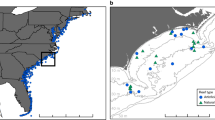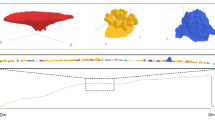Abstract
For reefs to form in wave-swept environments, the sessile organisms that build them need stable foundations1,2. Here we provide evidence that marine worms actively create patches of stable habitat on the sea bed which provide them with food and shelter. In so doing, they bring reef-building organisms together on hard surfaces and so create suitable conditions for reefs to develop.
Similar content being viewed by others
Main
While maintaining a tropical marine aquarium, we noticed that three small colonies (each weighing 5–20 g) of the scleractinian reef coral Lobophyllia hemprichii on the tank's sandy bed had moved 6–16 cm during the night. The corals had become attached by a glue-like substance to a fist-sized lump of reef rock covered in coralline algae. Two colonies were stuck to the side of the rock about 2–4 cm above the sand bed.
We detached the corals from the reef rock and returned them to their former locations. The corals made night-time journeys to the reef rock 21 times over a 1-month period. A 90-degree alteration in the position of the reef rock with respect to the corals, or of the corals with respect to the reef rock, resulted in similar agglomeration around and affixation to the upper or lower sides of the rock.
We made several unsuccessful attempts to film this process under very weak background incandescent white or red light (less than 3 μmol photons m−2 s−1) and intermittent weak white or red light (1 minute on, 15 minutes off). Under constant background lighting, there was no movement of corals to the rock. During intermittent light–dark cycles, the corals moved on some occasions, but always during the dark period. This indicated that the corals were being moved rapidly by some photophobic agent.
We next mounted a Hi-8 video camera, equipped with infrared emission, perpendicular to the aquarium overnight. Less than 1 hour after darkness, the head and upper body of a bootlace-thick eunicid worm appeared from a hole in the rock. The worm sought out a coral and dragged it to the reef rock in less than 2 seconds (Fig. 1).
Time-series images, captured from a video recording made under infrared illumination, of the rapid repositioning of a live scleractinian coral from sand bed to solid rock by a eunicid worm for the purposes of habitat assembly. The worm has been coloured to enhance visibility and the images have been adjusted using Adobe Photoshop to improve luminosity and contrast. The ruler in the background is graduated in centimetres and millimetres.
The persistent nightly efforts of the eunicid worm shown in Fig. 1 to expand and elaborate a durable habitat for itself suggest that such behaviour must have a genetic basis. Although immature, the worm shown in Fig. 1 could raise a 10-g piece of coral above the sand bed of the aquarium and cement it, with its photo-synthetic tissue orientated upwards, to the side of a piece of reef rock. Fully grown eunicid worms, which can be more than 2 m long3, must be able to assemble and bind together sizeable mounds of hard substrata.
The fossil record shows that the initial growth of coral reefs depends on the aggregation of sessile, skeleton-forming biota on a hard base1,2. It is not clear how these conditions arise on the shifting seafloors of continental shelf margins. Habitat construction by eunicid and related worms for protection and sustenance is a plausible explanation for both the patchy distribution of benthic communities in general and the development of coral reefs on otherwise unstable substrata1. By dragging together reef-building organisms and cementing them to mounds of hard substrata, they can assemble spatially heterogeneous, three-dimensional structures that trap sediments1, enhance settlement and growth of resident species4 and other reef biota1, and provide refuges for cryptic communities5,6.
References
Wood, R. Reef Evolution (Oxford Univ. Press, 1999).
Jackson, J. B. C. Am. Nat. 111, 743– 747 (1977).
Parker, S. P. Synopsis and Classification of Living Organisms 2 18– 19 (McGraw-Hill, New York, 1982).
Jackson, J. B. C. Bull. Mar. Sci. 39, 588– 606 (1986).
Jackson, J. B. C. & Winston, J. E. J. Exp. Mar. Biol. Ecol. 57, 135–147 (1982).
Adey, W. H. & Steneck, R. S. in The Ecology of Deep and Shallow Coral Reefs Vol. 2 (ed. Reaka, M. L.) 163– 187 (Office of Undersea Research, NOAA, Rockville, 1985).
Author information
Authors and Affiliations
Corresponding author
Rights and permissions
About this article
Cite this article
Chisholm, J., Kelley, R. Worms start the reef-building process. Nature 409, 152 (2001). https://doi.org/10.1038/35051660
Issue Date:
DOI: https://doi.org/10.1038/35051660
This article is cited by
-
Evidence for a local reef eclipse in a shallow marine carbonate environment following the regional extinction of archaeocyaths in Laurentia (Stage 4, Cambrian)
Facies (2020)
-
Paleoecology of Pennsylvanian phylloid algal buildups in south Guizhou, China
Facies (2007)
-
Coral reefs worm their way up
Nature (2001)
Comments
By submitting a comment you agree to abide by our Terms and Community Guidelines. If you find something abusive or that does not comply with our terms or guidelines please flag it as inappropriate.




